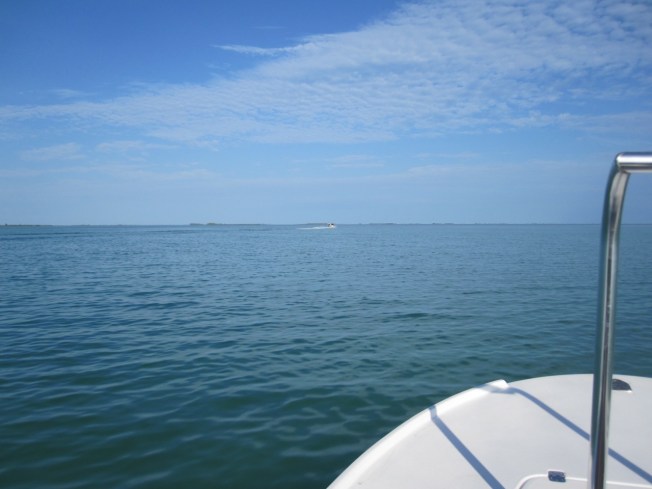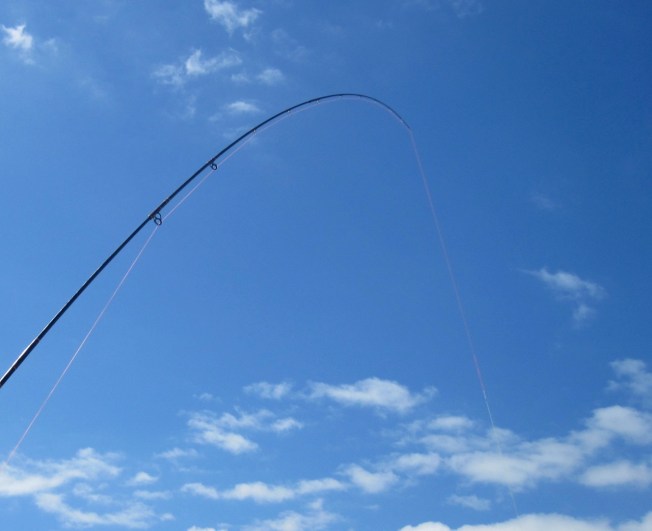
BABY BONEFISH, CASUARINA, ABACO: HIDING IN PLAIN SIGHT…
Bonefish are difficult to see in the water at the best of times. Shining silver out of water, but pale grey shadows underwater. Fishing under cloud cover and / or (especially ‘and’) when there’s a ripple on the water can be atritional. Sight-casting becomes impossible, and the best recourse is to locate the cloudy patches of water that show where the fish are feeding on the bottom. Chucking the fly into – or beyond – one of these and stripping back may be the only way to get a fish in such adverse conditions. What’s needed is clear sky, sunlight, good polaroids, patience, and keen eyes to scan the water for dark shadows moving across the sand… Or, in my case, simply waiting for the guide to hiss “Hey! Rolling Harbour. Three fish, 40 feet, 10 o’clock moving right, see them? Go now!”. By then, there’s a 50 / 50 chance I may have located them and got my act together enough to (try to) cast at them…
This picture of an adult fish, just caught on the Marls and released at once, shows how a bonefish can easily blend in with its underwater surroundings… but it can’t hide the dark shadow it casts.
Two days later we went to Casuarina with friends who wanted a day’s wading on the extensive flats there. This photo shows a juvenile fish close to the beach there, on a glorious sunny day with a light breeze (the header picture [double-click] was taken the same day – low water over pale sand as far as the eye can see). I’d never have noticed this little fish, had I not seen the dark shadow it cast on the sand, magnified by the distorting effect of the ripples.

Without the distortion from surface ripples, the bonefish shape can be clearly seen. It’s hard to imagine that by the time this little fish has reached a weight of 2 lbs, he will be capable of stripping your line down to the backing in seconds… or could he?

No, not, in fact. This fish, with its deeply forked ‘bonefish’ tail, is in fact a YELLOWFIN MOJARRA also known as shad. As Zach Zuckerman of the CAPE ELEUTHERA INSTITUTE writes in kindly emphasising that the fish above is not a bonefish, “the yellowfin mojarra… is related to the mottled mojarra mentioned in Chris Haak’s text (see below). Yellowfin mojarra and bones share the same habitats, and mojarra also feed off of benthic invertebrates”. Which brings me to some interesting recent findings by the CAPE ELEUTHERA INSTITUTE in conjunction with the BONEFISH & TARPON TRUST. We saw a single small fish. It looked like a bonefish (though I guess the yellow fin markings suggested otherwise). It was in fact a similar-looking species. Where are all the young bones? The babies? How do they protect themselves from the many predators of juvenile fish?
EVER WONDER WHY YOU DON’T SEE SCHOOLS OF TINY BONEFISH ON THE FLATS?
Article ref: blog.ceibahamas.org
 “Since May 2011, Christopher Haak, a PhD student (and avid fisherman) at the University of Massachusetts, Amherst, along with other scientists, has been trying to solve the mystery of where juvenile bonefish live, from settlement through the time they join adult populations on the flats. Exhaustive efforts to locate juveniles along the densely-developed coastlines of Florida were met with little success, leading researchers to the comparatively pristine shorelines of The Bahamas to continue their search.
“Since May 2011, Christopher Haak, a PhD student (and avid fisherman) at the University of Massachusetts, Amherst, along with other scientists, has been trying to solve the mystery of where juvenile bonefish live, from settlement through the time they join adult populations on the flats. Exhaustive efforts to locate juveniles along the densely-developed coastlines of Florida were met with little success, leading researchers to the comparatively pristine shorelines of The Bahamas to continue their search.
For the past one-and-a-half years, they have scoured the coastlines of South Eleuthera, conducting 1000+ seine hauls, encompassing a broad range of coastal habitats. This project is funded by Bonefish & Tarpon Trust and based out of CEI. These efforts (with the help of South-Eleutherans; thanks Denny and Kelsey Rankin!) have succeeded in locating over 800 juvenile bonefish as small as one inch in length, and have revealed some intriguing trends. For example, contrary to what might be expected, juvenile bonefish do not appear to frequent the mangrove creek systems or expansive tidal flats commonly used by adults, preferring instead to remain along shallow, sheltered shorelines near deeper basins or channels.”
Can you find the juvenile bonefish among the mojarra in the picture below?
“Perhaps the most remarkable finding to date is that nearly every bonefish collected was in the company of much greater numbers of like-sized mojarras (a common schooling baitfish known to Bahamians as shad). These juvenile bonefish exhibited markings and coloration not apparent in adult bonefish, but very similar to the mojarras with which they were caught. By blending in with considerably greater numbers of the model species, the mimics may be reducing their predation risk, and increasing their chances of survival. In the case of bonefish, this hypothesis would also explain why juveniles are so rarely observed; they are well hidden within schools of mojarras! From a conservation perspective, this suggests that bonefish populations may be dependent upon healthy mojarra populations, important information for resource managers.
This research is also producing valuable information about the diverse juvenile fish communities that inhabit Eleuthera’s shores. Myriad seine hauls of the island’s beaches, bays, sounds, and creeks have catalogued juvenile fishes from a wide array of species, including other flats inhabitants like permit, reef fish such as parrotfish, jacks, and wrasses, and some very unusual demersal critters such as shortnose batfish. The high densities and diversity of juvenile fishes revealed by this study serves to highlight the importance of these nearshore habitats to healthy adult fish populations of all kinds, underscoring the need to preserve and care for our coastlines.”
ADDENDUM With thanks to Aaron Adams of the BONEFISH & TARPON TROUT for use permission, here is a great size indicator for baby bonefish, taken by him some years back in connection with a juvenile bonefish project.

































You must be logged in to post a comment.